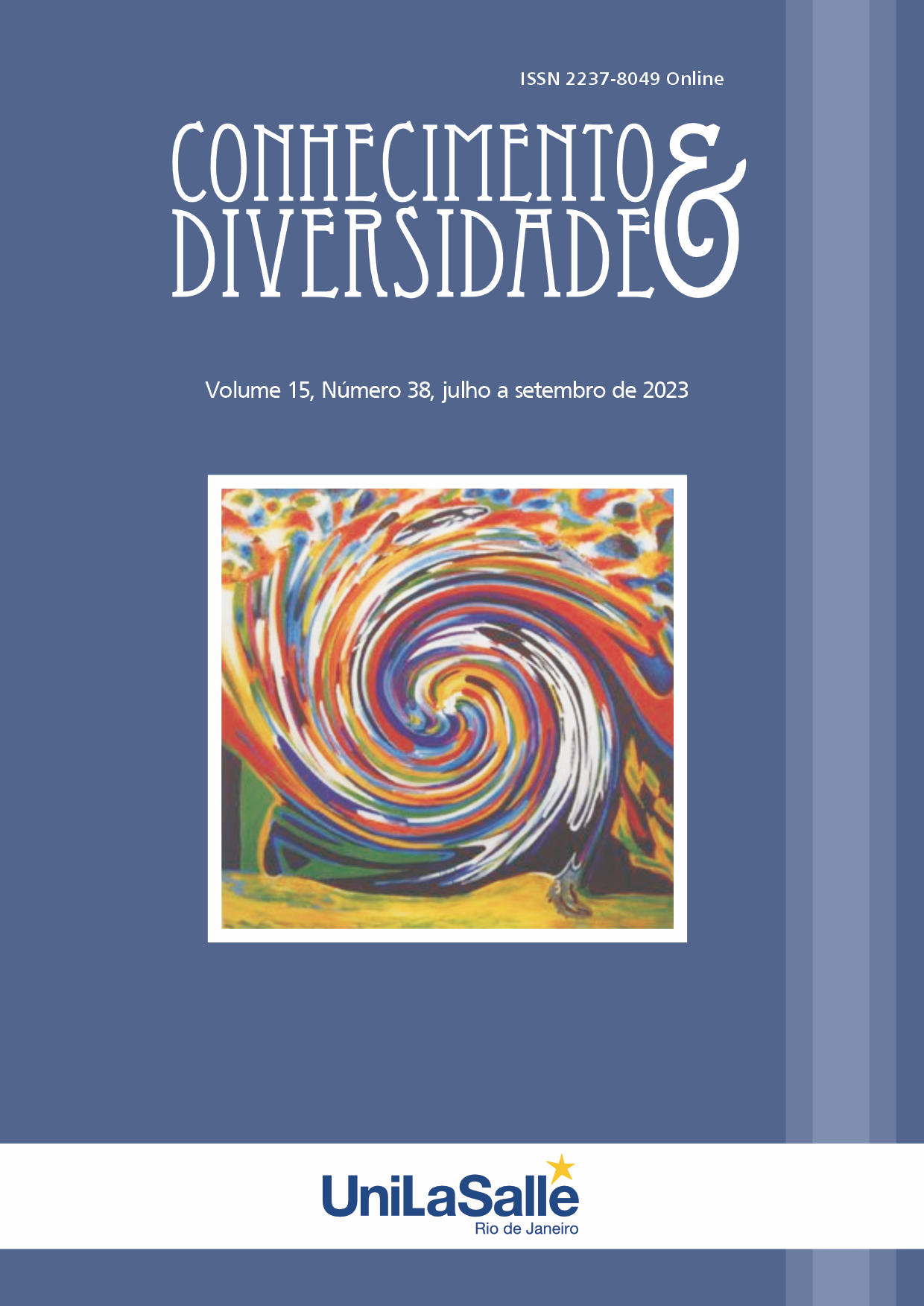PERCEPÇÕES DE ALUNOS DO ENSINO MÉDIO SOBRE O APRENDIZADO DE VOCABULÁRIO DE INGLÊS ATRAVÉS DE JOGOS
DOI:
https://doi.org/10.18316/rcd.v15i38.11043Palavras-chave:
Jogos. Ensino. Vocabulário. Alunos do ensino médio.Resumo
Aprender vocabulário é uma parte crucial do aprendizado da língua inglesa. Existem vários métodos que os professores podem empregar ao ensinar vocabulário aos alunos, especialmente alunos do ensino médio. Um desses métodos é ensinar vocabulário de forma mais eficiente, utilizando jogos educativos. A investigação desta pesquisa teve como foco a aprendizagem de vocabulário em uma escola de ensino médio. A pesquisa encontrou as perspectivas dos alunos em relação aos jogos usados para ensinar e aprender vocabulário para alunos da Binh Hung Hoa High School, na cidade de Ho Chi Minh. Os participantes foram 120 alunos do 10.º e 11.º anos com idades compreendidas entre os 16 e os 17 anos, todos não nativos, e 10 professores que lecionam nesta escola. O escritor realizou uma pesquisa de caso, questionário foi entregue aos alunos no final do curso para obter suas perspectivas sobre o aprendizado do vocabulário em inglês por meio de jogos. Além disso, 10 professores foram entrevistados sobre o uso de jogos no ensino de vocabulário em inglês. O estudo constatou que o uso de jogos educativos como estratégia de ensino e aprendizagem com jovens alunos impulsionou a aquisição e retenção de informações e ofereceu aos alunos a chance de entender como seu aprendizado foi usado no mundo real. Isso também é simples e agradável para os alunos, permitindo que eles se familiarizem com algumas palavras sem ter que relembrá-las palavra por palavra ou ficar entediados. Esta pesquisa aconselha o emprego de jogos educativos de forma mais inventiva no ensino de vocabulário aos alunos.
Referências
Aliaga, M., & Gunderson, B. (2000). Interactive Statistics. Saddle River, 3-15
Denzin, N. K., & Lincoln, Y. S. (2000). Handbook of Qualitative Research. Thousand Oaks: Sage Publications, Inc.
Griffee, D. T. (2012). An Introduction to Second Language Research Methods: Design and Data. Berkeley, CA.: TESL-EJ Publications
Hammer, J. (2008). The Practice of English Language Teaching. England: Pearson
Kealey, D. J., &Protheroe, D. R. (1996). The effectiveness of cross-cultural training for expatriates: An assessment of the literature on the issue. International Journal of Intercultural Relations, 20(2), 141-165
Longman. http://dx.doi.org/10.1093/elt/ccp007
Lewis, G. (1999). Games for children. New York: Oxford University Press.
Rixon, S. (1981). How to use games in language teaching. London: Macmillan.
(10) Uberman, A. (1998). The use of games for vocabulary presentation and revision. Forum, 36(1), 20-27.
Elyas, T., & Alfaki, I. (2014). Teaching vocabulary: The relationship between techniques of teaching and strategies of learning new vocabulary items. English Language Teaching, 7(10), 40–56. https://doi.org/10.5539/elt.v7n10p40
Carrier, M., & the Centre for British Teachers. (1985). Take 5. Games and activities for the language learners . GB: Nelson and Sons Ltd.
Hadfield, J. (1998). Elementary vocabulary games. Harlow: Pearson Education Limited. September 11, 2013, from http://exchanges.state.gov/forum/vols/vol36/no1/p20.htm
Wright, A., Betteridge, D., & Buckby, M. (2005). Games for language learning (3rd ed.). New York: Cambridge University Press.
Uberman, A. (1998). The use of games for vocabulary presentation and revision. English Teaching Forum, 36(1), 20-27. Retrieved September 11, 2013, from http://exchanges.state.gov/forum/vols/vol36/no1/p20.htm
Ersoz, A. (2000, June). Six games for EFL/ESL classroom. The Internet TESL Journal, 6(6), retrieved February 11, 2005 from http://iteslj.org/Lessons/Ersoz-Games.html
Gardner, H. (1999). Intelligence reframed: Multiple intelligences for the 21st century.
New York, NY: Basic Books.
Hadfield, J. (1999). Intermediate vocabulary games. Harlow, Essex: Longman.
Jacobs, G. M., & Kline Liu, K. (1996). Integrating language functions and collaborative skills in the second language classroom. TESL Reporter, 29, 21-33.
Johnson, D. W., Johnson, R. T., & Stanne, M. B. (2000). Cooperative learning methods: A meta-analysis. Cooperative Learning Center, University of Minnesota. Retrieved February 12, 2006, from http://www.co-operation.org/pages/cl-methods.html.
Kodotchigova, M. A. (2002, July). Role play in teaching culture: Six quick steps for classroom implementation. Internet TESL Journal, 8(7). Retrieved February 13, 2006, from http://iteslj.org/Techniques/Kodotchigova-RolePlay.html
Krashen, S.D. (1985). The input hypothesis: Issues and implications. New York: Longman.
Lee, S. K. (1995, January-March). Creative games for the language class. Forum, 33(1), 35. Retrieved February 11, 2006 from http://exchanges.state.gov/forum/vols/vol33/no1/P35.htm
Lee, W. R. (1979). Language teaching games and contests. Oxford: Oxford University Press.
Nguyen Thi Thanh Huyen & Khuat Thi Thu Nga. (2003, December). Learning vocabulary through games. Asian EFL Journal, 5(4). Retrieved February 13, 2006, from http://www.asian-efl-journal.com/dec_03_sub.Vn.php
Orlick, T. (2006). Cooperative games and sports: Joyful activities for everyone. Champaign, IL: Human Kinetics.
Richard-Amato, P. A. (1988). Making it happen: Interaction in the second language classroom: From theory to practice. New York: Longman.
Rixon, S. (1981). How to use games in language teaching. London: Macmillan.
Wright, A., Betteridge, D., & Buckby, M. (2005). Games for language learning (3rd ed.). New York: Cambridge University Press.
Riedle C. Web 2.0: helping reinvent education / C.Riedle, 2008. – Available at: http://www.thejournal.com/articles/21907.
Downloads
Publicado
Edição
Seção
Licença
Copyright (c) 2023 Vo Tu Phuong, Nguyen Thi Phi Phuong

Este trabalho está licenciado sob uma licença Creative Commons Attribution 4.0 International License.
Conforme recomendado pelo o Public Knowledge Project, a RCD adota para seus artigos uma licença CREATIVE COMMONS: Atribuição CC BY 4.0.
Esta licença permite que outros distribuam, remixem, adaptem e construam sobre o seu trabalho, mesmo comercialmente, desde que lhe dêem crédito pela criação original.
Esta é a licença mais adequada oferecida.
Recomendado para a máxima divulgação e uso de materiais licenciados.



